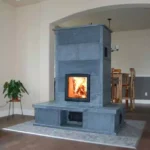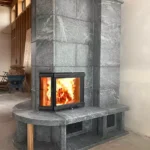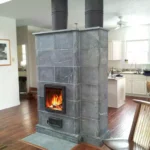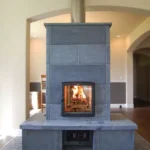IDENTIFYING THE PROPER MASONRY HEATER SIZE
Efficiency claims in literature regarding masonry heaters varies, and there is little information on how the figures were acquired. The purpose of the following discussion is to give the basic information on how the figures are achieved. Keep in mind there are a number of variables that affect any specific circumstance, such as weather, location, etc. Sometimes the ultimate decision on the size of a heater is as much an art as a craft or science.
Net Energy Yield of Wood
While the energy content of wood can be expressed based on volume or weight, split wood is not of uniform size, so using weight is more practical for laboratory tests. Rather surprisingly, the differences in the weight-based energy yield between diverse tree species are not very large. However, pound for pound dense hardwoods, such as oak or hickory, are only about half the size of pine, spruce, fir or cedar.

Reducing the moisture content of the fuel is the only thing that can be done to improve the above figures. The figure must be multiplied by the overall thermal efficiency of the stove, heater or fireplace. The difference can be huge and can range from -10% to +90% depending on the unit used.
Masonry Heater Radiant Heat
- A number of components determines the amount of the heat actually transferred into the room, as follows:
- Combustion efficiency. The efficiency of all new technology stoves is in the 90 per cent range. Older stoves and heaters will vary.
- Heat transfer (thermal) efficiency. The firing strategy of the operator and the thermal mass of the heater determines how much of the heat generated in the fire box escapes through the chimney into the atmosphere. Newer metal wood stoves and fireplace inserts with fire brick lining are designed to be clean burning. Nevertheless, because they lack the thermal mass which acts as a heat exchanger, they still have poor thermal efficiency. Although the overall efficiency equals the combustion efficiency multiplied by the heat transfer efficiency, overall efficiency does not fully describe the true efficiency of a heater. Consider the following.
- Continuity of output.If a stove or heater has little or no thermal mass in which to store heat, all the heat is transferred into the room during the burn time. If the fire is allowed to burn rapidly, the room becomes overheated. After the fire dies down, the room becomes underheated and uncomfortable as it cools down quickly. Because of the higher temperature differential between the room air and the outdoor air, an overheated room loses more heat to the environment. With a masonry heater, this uncomfortable and inefficient cycle does not exist. The heat from the fire is transferred into the masonry (thermal mass) and is radiated slowly into the room creating a comfortable, safe and healthy environment inside the room.
- Partial charge efficiency. Because high temperatures are needed to obtain non-smoldering combustion, many stoves do not handle small fuel charges efficiently. Soapstone masonry heaters can handle all reasonable fuel charges with equal efficiency. A small fire on milder days of the cooler seasons is possible and efficient as the heat is still stored and distributed in the same manner as colder days, which is an important feature.
Soapstone masonry heaters combine all four of the above categories!




